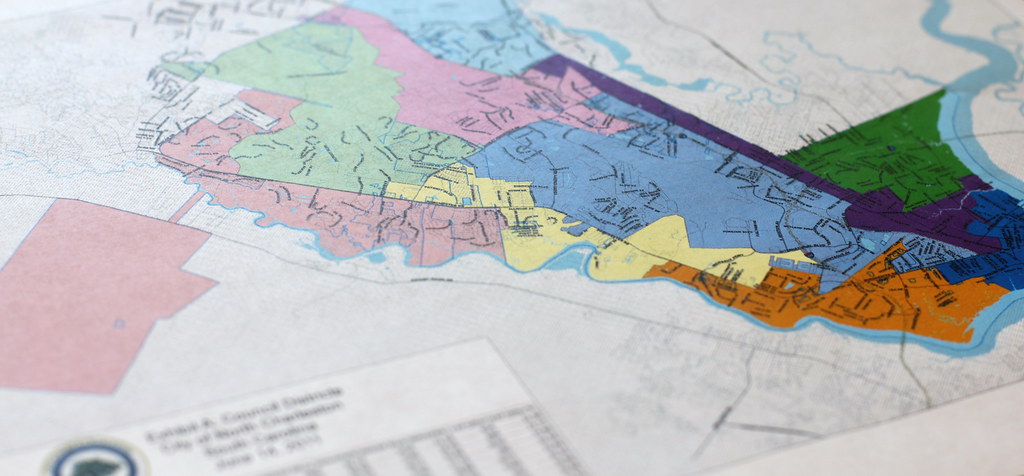Also available in Spanish
As redistricting ends in over half the country, the new maps in southern states–far from being “race blind”–have reduced or dismantled electoral opportunities for the region’s fast growing communities of color.
The harsh diagnosis was shared by experts convened by Ethnic Media Services on Jan. 14. Combined with a “tidal wave” of new voter restrictions, the “extreme racial gerrymandering” and “partisan gerrymandering” represent an unprecedented threat to participatory democracy, speakers warned.
In the words of Charles Mann, a redistricting activist in Spartanburg, South Carolina, “If you can’t believe now that our democracy is under attack, you must be tone deaf.”
“By ignoring where black people live, where Latinx people live, where AAPI communities are in North Carolina, you’re ignoring the humanity of voters who are trying to elect candidates of choice,” said Mitchell Brown, Voting Rights Counsel at the Southern Coalition of Social Justice. “You are not allowing them to be full citizens of the states in which they live.”
Brown noted that for southern states this is the first round of redistricting since the Supreme Court’s 2013 Shelby County decision ended the preclearance provisions of the Voting Rights Act. “So states don’t fear retribution from the federal government or from the courts. They are drawing maps that dilute the voting power of the very populations that have grown exponentially…They are leaving it up to civil rights attorneys to challenge them and tell them they’re wrong.”
Brown’s organization recently filed a lawsuit in the state court challenging North Carolina’s maps because the legislators ignored the racial data when they drew the districts. Although they lost the case, the state Supreme Court is hearing the appeal arguments on February 2.
Texas gained two new seats in Congress based on census data, a growth fueled by people of color. But the maps drawn do not reflect these communities and instead make the new districts more white and safer for Republicans.
Deborah Chen, a lawyer and community organizer with OCA-Asian Pacific American Advocates in Texas, said that while legislators were working on the maps, her coalition requested public audiences and participatory comments.
“What happened was we would get notifications in the middle of the night, that the hearing is going to be in one day or two days, and it may or may not be available virtually.” The maps were not made available in advance, there was no information to understand how lines were drawn, and therefore, a congressional district like District 22 “was drawn to make it more white.”
Some residents even flew from El Paso to Austin to attend a hearing, but names that sounded ethnic were never called to speak. “For those of us who sat there from 8 o’clock in the morning until almost eight o’clock at night, we were the only remaining people of color in the room who hadn’t spoken,” Chen said. “They were just hoping we would give up.”
As for next steps, Chen said “There is this other layer of voter suppression bills that we’re working hard to try and prevent so people won’t literally be lifted off the voting rolls. We’re trying to help people find out information about how to get registered and where to go to vote.”
As for South Carolina, Mann prefaced his remarks by saying “it breaks my heart we’re having to deal with such viciousness over the drawing of lines, or creating fair opportunities to elect people that we want.” The maps for the State House were signed by the governor even though the congressional seats are still under consideration. None of the Democratic members of the Senate committee were consulted before the Senate maps were released to the public, even though the committee had received input from the National Republican Redistricting Trust.
Lawsuits challenging the maps have been filed. But Mann and other redistricting advocates have turned their attention to organizing local redistricting advisory committees “where things are more personal.” The aim is to make people aware that the same struggle for representation at the state and federal level is just as urgent at the local level.
“Some people had never seen a city council district map or a school board district map. Some people didn’t know what district they were in,” he explained. “We had a lot of education to do… but now we can focus on the upcoming election cycles, and we can increase voter awareness.”
Their efforts aim to counter the current assault on voting rights across the country. The Democracy Program at the Brennan Center for Justice has identified 19 states that passed 34 laws restricting access to the right to vote in 2021, “a tidal wave of laws that will continue in 2022,” said Sean Morales-Doyle, the program’s Acting Director. “We are starting the year off with more bills restricting access to voting pending in state legislatures than we normally see in an entire year.”
One key trend, Morales-Doyle said, are laws aimed at restricting access to mail voting – a trend that happened immediately following the 2020 elections when there was a dramatic increase in people voting by mail. “As we see people of color using new methods of voting, then the response is to start restricting those methods of voting. New restrictions piled on old restrictions… it’s carving away votes here and there, making it harder for certain groups, particularly voters of color, to vote.
“Congress needs to act and pass the John R. Lewis Act (pending in the Senate), it will restore the voting rights and stop maps from being drawn in a way that discriminates against voters of color,” he concluded.




